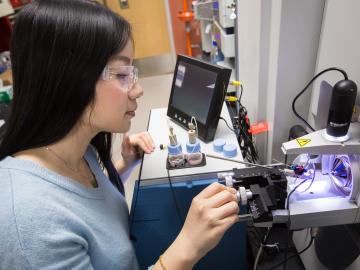
Filter News
Area of Research
- (-) Biological Systems (2)
- (-) Fusion Energy (1)
- (-) Materials (43)
- (-) Supercomputing (64)
- Advanced Manufacturing (5)
- Biology and Environment (93)
- Biology and Soft Matter (1)
- Building Technologies (4)
- Computational Engineering (1)
- Computer Science (3)
- Electricity and Smart Grid (1)
- Energy Science (135)
- Energy Sciences (1)
- Functional Materials for Energy (1)
- Fusion and Fission (8)
- Isotope Development and Production (1)
- Isotopes (27)
- Materials for Computing (7)
- Mathematics (1)
- National Security (36)
- Neutron Science (14)
- Nuclear Science and Technology (10)
- Quantum information Science (3)
- Sensors and Controls (1)
News Topics
- (-) Bioenergy (20)
- (-) Buildings (8)
- (-) Cybersecurity (8)
- (-) Frontier (32)
- (-) Isotopes (14)
- (-) Security (7)
- (-) Space Exploration (5)
- 3-D Printing/Advanced Manufacturing (26)
- Advanced Reactors (11)
- Artificial Intelligence (39)
- Big Data (22)
- Biology (14)
- Biomedical (23)
- Biotechnology (2)
- Chemical Sciences (32)
- Clean Water (3)
- Composites (9)
- Computer Science (100)
- Coronavirus (17)
- Critical Materials (15)
- Energy Storage (37)
- Environment (35)
- Exascale Computing (26)
- Fusion (18)
- Grid (9)
- High-Performance Computing (45)
- Irradiation (1)
- ITER (1)
- Machine Learning (15)
- Materials (79)
- Materials Science (83)
- Mathematics (2)
- Microscopy (29)
- Molten Salt (3)
- Nanotechnology (42)
- National Security (8)
- Neutron Science (42)
- Nuclear Energy (27)
- Partnerships (11)
- Physics (34)
- Polymers (18)
- Quantum Computing (21)
- Quantum Science (33)
- Simulation (16)
- Software (1)
- Summit (43)
- Transportation (19)
Media Contacts

Systems biologist Paul Abraham uses his fascination with proteins, the molecular machines of nature, to explore new ways to engineer more productive ecosystems and hardier bioenergy crops.

Scientists at Oak Ridge National Laboratory and Ohio State University discovered a new microbial pathway that produces ethylene, providing a potential avenue for biomanufacturing a common component of plastics, adhesives, coolants and other

From materials science and earth system modeling to quantum information science and cybersecurity, experts in many fields run simulations and conduct experiments to collect the abundance of data necessary for scientific progress.

Five researchers at the Department of Energy’s Oak Ridge National Laboratory have been named ORNL Corporate Fellows in recognition of significant career accomplishments and continued leadership in their scientific fields.

Scientists at ORNL used neutron scattering and supercomputing to better understand how an organic solvent and water work together to break down plant biomass, creating a pathway to significantly improve the production of renewable

Research by an international team led by Duke University and the Department of Energy’s Oak Ridge National Laboratory scientists could speed the way to safer rechargeable batteries for consumer electronics such as laptops and cellphones.

Oak Ridge National Laboratory researchers have developed a thin film, highly conductive solid-state electrolyte made of a polymer and ceramic-based composite for lithium metal batteries.

The prospect of simulating a fusion plasma is a step closer to reality thanks to a new computational tool developed by scientists in fusion physics, computer science and mathematics at ORNL.

Energy storage startup SPARKZ Inc. has exclusively licensed five battery technologies from the Department of Energy’s Oak Ridge National Laboratory designed to eliminate cobalt metal in lithium-ion batteries. The advancement is aimed at accelerating the production of electric vehicles and energy storage solutions for the power grid.

Gina Tourassi has been appointed as director of the National Center for Computational Sciences, a division of the Computing and Computational Sciences Directorate at Oak Ridge National Laboratory.


